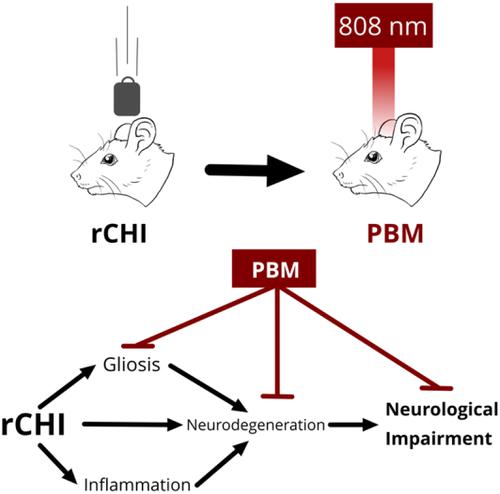当前位置:
X-MOL 学术
›
J. Biophotonics
›
论文详情
Our official English website, www.x-mol.net, welcomes your feedback! (Note: you will need to create a separate account there.)
Photobiomodulation therapy for repeated closed head injury in rats.
Journal of Biophotonics ( IF 2.8 ) Pub Date : 2019-11-25 , DOI: 10.1002/jbio.201960117 Baocheng Yang 1, 2 , Juanyong Xu 3, 4 , Yong Li 5 , Yan Dong 5 , Yuyu Li 1, 2 , Lorelei Tucker 5 , Luodan Yang 5 , Xuemei Zong 1, 2 , Chongyun Wu 5 , Tie Xu 1, 2, 6 , Shuqun Hu 1, 2 , Quanguang Zhang 5 , Xianliang Yan 1, 2
Journal of Biophotonics ( IF 2.8 ) Pub Date : 2019-11-25 , DOI: 10.1002/jbio.201960117 Baocheng Yang 1, 2 , Juanyong Xu 3, 4 , Yong Li 5 , Yan Dong 5 , Yuyu Li 1, 2 , Lorelei Tucker 5 , Luodan Yang 5 , Xuemei Zong 1, 2 , Chongyun Wu 5 , Tie Xu 1, 2, 6 , Shuqun Hu 1, 2 , Quanguang Zhang 5 , Xianliang Yan 1, 2
Affiliation

|
Repeated traumatic brain injury, leads to cumulative neuronal injury and neurological impairments. There are currently no effective treatments to prevent these consequences. Growing interest is building in the use of transcranial photobiomodulation (PBM) therapy to treat traumatic brain injury. Here, we examined PBM in a repeated closed head injury (rCHI) rat model. Rats were administered a total of three closed head injuries, with each injury separated by 5 days. PBM treatment was initiated 2 hours after the first injury and administered daily for a total of 15 days. We found that PBM‐treated rCHI rats had a significant reduction in motor ability, anxiety and cognitive deficits compared to CHI group. PBM group showed an increase of synaptic proteins and surviving neurons, along with a reduction in reactive gliosis and neuronal injury. These findings highlight the complexity of gliosis and neuronal injury following rCHI and suggest that PBM may be a viable treatment option to mitigate these effects and their detrimental consequences.
中文翻译:

光生物调节疗法用于大鼠反复闭合性颅脑损伤。
反复的外伤性脑损伤,导致累积性神经元损伤和神经系统损伤。当前没有有效的方法来防止这些后果。经颅光生物调节(PBM)疗法用于治疗颅脑损伤的兴趣日益浓厚。在这里,我们检查了反复闭合性颅脑损伤(rCHI)大鼠模型中的PBM。总共对大鼠进行了三次闭合性颅脑损伤,每次损伤相隔5天。首次受伤后2小时开始进行PBM治疗,每天进行总共15天的治疗。我们发现,与CHI组相比,PBM治疗的rCHI大鼠的运动能力,焦虑和认知缺陷明显减少。PBM组显示突触蛋白增加和存活的神经元减少,反应性神经胶质增生和神经元损伤减少。
更新日期:2019-11-25
中文翻译:

光生物调节疗法用于大鼠反复闭合性颅脑损伤。
反复的外伤性脑损伤,导致累积性神经元损伤和神经系统损伤。当前没有有效的方法来防止这些后果。经颅光生物调节(PBM)疗法用于治疗颅脑损伤的兴趣日益浓厚。在这里,我们检查了反复闭合性颅脑损伤(rCHI)大鼠模型中的PBM。总共对大鼠进行了三次闭合性颅脑损伤,每次损伤相隔5天。首次受伤后2小时开始进行PBM治疗,每天进行总共15天的治疗。我们发现,与CHI组相比,PBM治疗的rCHI大鼠的运动能力,焦虑和认知缺陷明显减少。PBM组显示突触蛋白增加和存活的神经元减少,反应性神经胶质增生和神经元损伤减少。



























 京公网安备 11010802027423号
京公网安备 11010802027423号